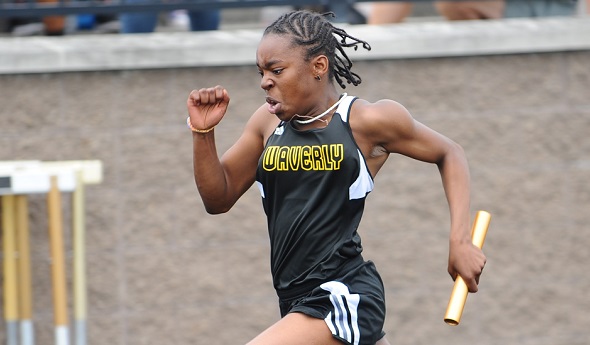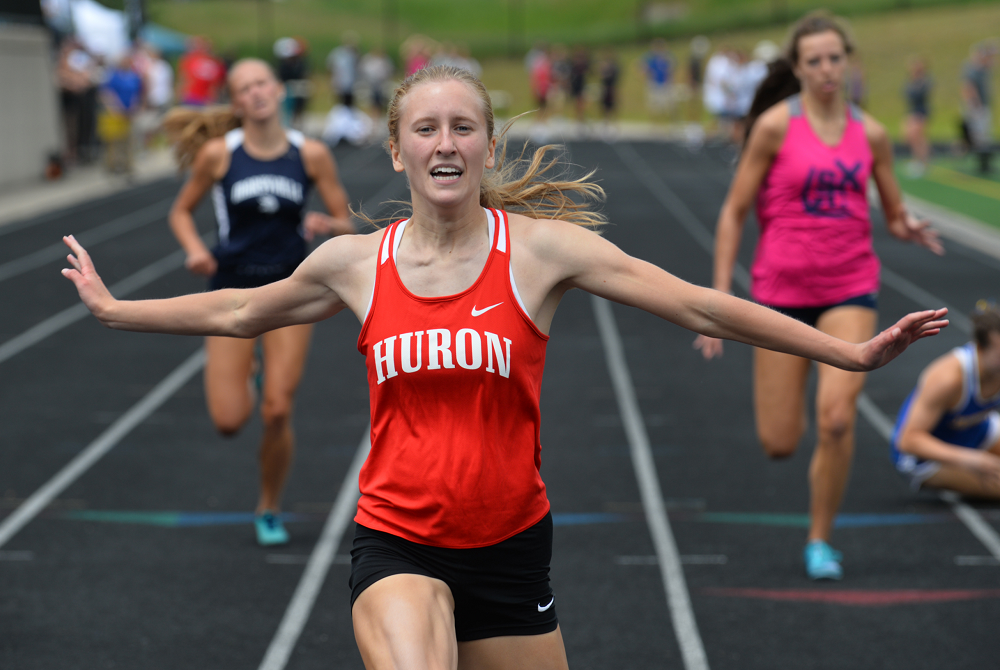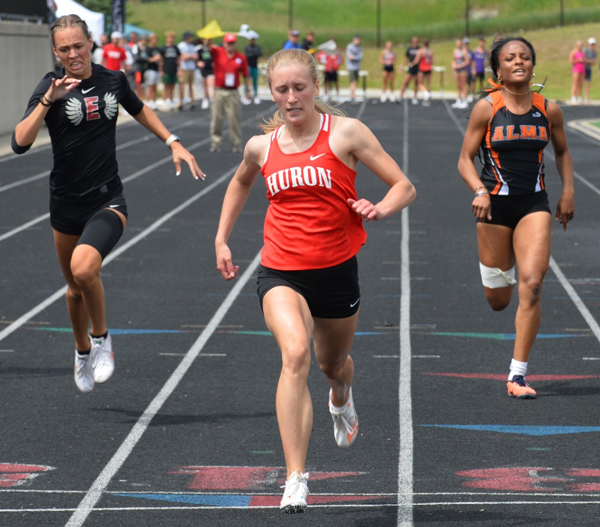
Waverly Paces 1st-Time Winners in D2
By
Tom Markowski
Special for Second Half
June 4, 2016
ZEELAND – Quite possibly the most diminutive athlete at the Lower Peninsula Division 2 Track & Field Finals on Saturday, sophomore Kayla Windemuller of Holland Christian twice fell to the track at Zeeland Stadium and twice got back on her feet, kept her composure and finished the 3,200-meter run before anyone else.
About an hour earlier, Windemuller won her first individual MHSAA championship, in the 1,600 run.
Nikole Sargent of Flint Powers Catholic also was a double winner taking first in the shot put and the discus. Sargent won the shot put last season as a junior, but said going into this meet that the discus event was a priority. Sargent failed to place in the discus a year ago, fueling her motivation.
Although Tra’chele Roberts of Lansing Waverly took home only one individual first-place medal, her performances helped her team earn the school’s first MHSAA Finals team championship, as it edged second-place Powers, 42 points to 40. Romulus was third with 31 points, followed by Grand Rapids South Christian with 26 and Zeeland East with 24.
Roberts won the 100 dash (12.55) and ran anchor on the winning 400 and 800 relay teams. The 400 relay set a school record with a time of 48.7.
Warriors coach Rex Wilkes, a Waverly graduate, is in his second season running the program and said he kept Roberts, one of three sophomores on the relay teams, out of the 200 dash in an attempt to save her for the relays.
“We didn’t expect this,” Wilkes said. “I was hoping to come out with some fast times. We got some unexpected points in the shot put. Tra’chele can score points on her own. The others can score in the Regionals and run in the relays.”
The other three athletes on the relay teams were sophomores Jazlynn Wilcox and Maya Garrett, and junior Teaghan Thomas.
“It’s very exciting,” Thomas said. “I’ve been at states three times. We’ve been together since the seventh grade. The same girls ran on the relays, and in the same order.”
Thomas led off, followed by Wilcox, Garrett and Roberts.
Last season Waverly also took first in the 400 relay, but no individual placed among the top eight in the 100 dash.
To Wilkes’ point, another factor in the Warriors; breakthrough took place in the field events. Sophomore Malin Smith was sixth after the preliminaries, then moved up to second with a final put of 42 feet. Smith also took fifth in the discus, an event in which she was seeded seventh.
 Windemuller was seeded first and third, respectively, in the 1,600 and 3,200 runs, so it’s not surprising she ran well Saturday. She did place seventh in the 3,200 and eighth in the 1,600 last season, so there was some valuable experience gained there.
Windemuller was seeded first and third, respectively, in the 1,600 and 3,200 runs, so it’s not surprising she ran well Saturday. She did place seventh in the 3,200 and eighth in the 1,600 last season, so there was some valuable experience gained there.
No one could predict the events that took place and the circumstances that led to her taking first in both this time.
Windemuller, who said she’s 5-foot-1, won the 1,600 (4:58.9) in rather mundane fashion, at least in comparison to her 3,200 trip. She held off a late charge by junior Christina Sawyer of Tecumseh (5:00.2) in a tight race indeed – and Windemuller had to work for it.
“”It made me super nervous knowing she was close by,” Windemuller said. “I was very tired. I gave it everything I had.”
That was small potatoes compared to her extraordinary effort in the 3,200. With approximately two laps remaining Windemuller, Sawyer and junior Erika Freyhof of Hamilton were bunched together at the front. Suddenly, all three fell.
“I got up as quickly as I could,” Windemuller said. “I was still tired from running the (1,600). … I felt so bad. It was like dominos.”
The second spill took place with just over a lap remaining.
“I was in front,” Windemuller said. “When you go down you have to get yourself back up. It was a great learning experience.
“I’m small, but I’m feisty.”
Her time was 10:59.52.
Courageous athletes dotted the green artificial surface, home to both football teams at Zeeland East and Zeeland West. One competitor, in particular, is a multi-sport athlete who played four years of varsity basketball and was a two-sport athlete during the spring season.
Haley Hoogenraad of Zeeland West is one of the state’s top softball players. She will play for coach Carol Hutchins next year at University of Michigan. Hoogenraad competed in the 3,200 relay Saturday morning, then changed uniforms in a car as she was driven to Holland Christian to play in a Division 2 District Semifinal. West lost that noon game to Hudsonville Unity Christian, 12-4, allowing Hoogenraad to get back in a car to be driven back to Zeeland for the 800 run.
Hoogenraad was not just a qualifier in the event. She was seeded first, and as the race unfolded she moved up from fifth place to second with 200 meters left. Hoogenraad grew tired and placed fourth.
“I slid a few times and dove for a few balls,” Hoogenraad said of her time on the softball diamond. “I was dirty. I’m sad of the outcomes, but I tried. I tried to make my move (in the 800) and I said, oh, I can’t. I’m glad I had the opportunity to support my team.”
That would be teams.
PHOTOS: (Top) Lansing Waverly's Tra’chele Roberts runs a relay anchor leg for the Warriors, who went on to win the LP Division 2 championship. (Middle) Holland Christian's Kayla Windemuller. (Photos by Dave McCauley/RunMichigan.com.)

Multi-Sprint Champ Racing to Finish Huron Career Ahead of the Rest Again
By
Keith Dunlap
Special for MHSAA.com
May 25, 2023
NEW BOSTON – If there was one thing Elizabeth Anderson took pride in elementary school, it was simply showing that she could outrun everyone in sight.
 In fact, Anderson has an explanation for all the success she had in those playground races.
In fact, Anderson has an explanation for all the success she had in those playground races.
“Dominance when you are in elementary school,” Anderson quipped. “I don’t think I ever had a nickname. I just think everyone knew I was fast.”
Years later, pretty much everyone who follows track & field in the state of Michigan can attest to that.
A senior for New Boston Huron, Anderson has been faster than most other competitors in the state during her three-year high school career (with her freshman season in 2020 canceled due to COVID-19).
Last year, Anderson won titles at the Lower Peninsula Division 2 Finals in the 200-meter (25.07) and 400-meter (56.28) dashes, and was runner-up in the 100-meter dash (12.23).
Often, top sprinters focus on one or two of those three races. But Anderson is certainly a different breed of sprinter because she does all three.
In fact, she holds school records in all three of those events, and if all that weren’t enough, Anderson is a part of all three sprint relay teams.
“It is hard to give her events off,” said New Boston Huron head girls track coach Danielle Lobato.
Despite the different styles the 100, 200 and 400-meter dashes present, Anderson said there usually isn’t much adjusting when she goes from one of those races to another.
 The strategy is simply, “Let’s beat the other girls to the finish line.”
The strategy is simply, “Let’s beat the other girls to the finish line.”
“I don’t really go into each race changing up how I would run,” she said.
While enjoying and succeeding in all three races, Anderson said she actually does have a favorite among them.
“I would say the 400 is probably my favorite,” she said. “Even though it hurts, it’s satisfying to see how much you can get your time down in the 400 compared to any other race.”
Anderson said she started running track in sixth grade, but really got serious about it during the summer after her sophomore season, when she was invited to run for a local club.
Eventually, that led to her competing over the winter in indoor events.
She lived and breathed track so much that last fall, she decided to not run cross country so she could focus on a weightlifting regimen aimed at developing more leg strength.
“Once I started doing summer track, I realized I wanted to be doing this all the time,” she said.
Lobato said oftentimes in practice, Anderson is a de facto coach, given there is no better person she can think of for the younger runners on the team to learn from.
“I can’t always demonstrate these things I’m trying to teach,” she said. “You get to see it in real life (from Anderson), not in a YouTube video.”
After winning the 100, 200 and 400-meter dashes at her Regional meet last week, Anderson has her sights set on achieving the same trifecta of titles at next Saturday’s Finals in Grand Rapids.
Anderson has signed to run track at Michigan State, but has been plenty motivated to keep producing this spring in her final high school season.
“I’m really looking to defend my titles,” she said. “That is what is really motivating me to keep going. I want to keep in shape for the college season. I don’t want to lose any of the progress I have made. Ultimately, I just love running track.”
And since elementary school, Anderson has loved — and succeeded in — outrunning everyone else to the finish line.
“We knew we were getting something special,” Lobato said of when Anderson arrived in high school. “But you never expect this. All that she has accomplished is amazing.”
 Keith Dunlap has served in Detroit-area sports media for more than two decades, including as a sportswriter at the Oakland Press from 2001-16 primarily covering high school sports but also college and professional teams. His bylines also have appeared in USA Today, the Washington Post, the Detroit Free Press, the Houston Chronicle and the Boston Globe. He served as the administrator for the Oakland Activities Association’s website from 2017-2020. Contact him at [email protected] with story ideas for Oakland, Macomb and Wayne counties
Keith Dunlap has served in Detroit-area sports media for more than two decades, including as a sportswriter at the Oakland Press from 2001-16 primarily covering high school sports but also college and professional teams. His bylines also have appeared in USA Today, the Washington Post, the Detroit Free Press, the Houston Chronicle and the Boston Globe. He served as the administrator for the Oakland Activities Association’s website from 2017-2020. Contact him at [email protected] with story ideas for Oakland, Macomb and Wayne counties
PHOTOS (Top) New Boston Huron's Elizabeth Anderson clears the finish line during last season's LPD2 400 race. (Middle) Anderson, middle, outpaces the field to also win the 200. (Click for more from RunMichigan.com.)

